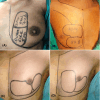Bilobed Pectoralis Major Myocutaneous Flap Reconstruction: a Single Institution Experience of 150 Patients and Methods to Prevent Complications
- PMID: 38601219
- PMCID: PMC11001805
- DOI: 10.1007/s12663-020-01485-x
Bilobed Pectoralis Major Myocutaneous Flap Reconstruction: a Single Institution Experience of 150 Patients and Methods to Prevent Complications
Abstract
Introduction: Bilobed PMMC flap is done for patients who have diseases that require resection of oral cavity mucosa along with the overlying skin, either because of direct tumor invasion to the skin or for achieving adequate tumor-free base of resection. The versatility of the flap allows it to be used to cover both inner and outer linings for a full-thickness defect.
Materials and methods: This was a single-center, retrospective, observational study carried out in the Department of Head and Neck Oncology at a regional cancer center from January 2019 to December 2019. A minimum follow-up duration for all patients was 6 months. The primary endpoint was to study the results and complications associated with bilobed PMMC flap reconstruction and factors affecting it, as well as their management.
Results: The median age was 45 years [24-71 years]. There were 96(64%) males and 54(36%) females. The most common sites reconstructed were lower gingivobuccal sulcus (39.1%), buccal mucosa (30.2%), and lower alveolus (16.7%). The overall complication rate was 41.3%, with 10(6.6%) patients requiring re-exploration. The average hospital stay was 11 days [5-28 days]. On doing a multivariate analysis, for various factors affecting flap necrosis, none of the factors reached statistical significance (p value > 0.05).
Conclusion: PMMC flap remains the workhorse of head and neck reconstruction. In cases of full-thickness defects in oral cancer patients, in our country, in the setup which lacks the expertise in microvascular anastomosis and with immense caseload in the head and neck cancer department, bilobed PMMC flap remains a safe and favorite alternative method for reconstruction.
Keywords: Advanced resection; Bilobed; Free flaps; Full-thickness defects; Pectoralis major myocutaneous flap.
© The Association of Oral and Maxillofacial Surgeons of India 2021.
Conflict of interest statement
Conflict of interestThe authors declare no conflict of interest.
Figures





Similar articles
-
Bipaddle Pectoralis Major Myocutaneous Flap for Single Stage Reconstruction of Oromandibular Defects.Indian J Otolaryngol Head Neck Surg. 2020 Mar;72(1):44-48. doi: 10.1007/s12070-019-01731-w. Epub 2019 Aug 19. Indian J Otolaryngol Head Neck Surg. 2020. PMID: 32158654 Free PMC article.
-
Bilobed PMMC in Females: Our Challenging yet Meritorious Experience.Indian J Surg Oncol. 2021 Mar;12(1):39-47. doi: 10.1007/s13193-020-01223-2. Epub 2020 Oct 8. Indian J Surg Oncol. 2021. PMID: 33814830 Free PMC article.
-
The folded, bipaddled pectoralis major myocutaneous flap for complex oral cavity defects: Undiminished relevance in the era of free flaps.JPRAS Open. 2020 Nov 25;27:108-118. doi: 10.1016/j.jpra.2020.11.007. eCollection 2021 Mar. JPRAS Open. 2020. PMID: 33457486 Free PMC article.
-
Pectoralis major myocutaneous flap.Oral Maxillofac Surg Clin North Am. 2014 Aug;26(3):421-6. doi: 10.1016/j.coms.2014.05.010. Oral Maxillofac Surg Clin North Am. 2014. PMID: 25086697 Review.
-
Pectoralis major myocutaneous pedicled flap in head and neck reconstruction: retrospective review of indications and results in 244 consecutive cases at the Toronto General Hospital.J Otolaryngol. 2001 Feb;30(1):34-40. doi: 10.2310/7070.2001.21011. J Otolaryngol. 2001. PMID: 11770971 Review.
References
LinkOut - more resources
Full Text Sources
